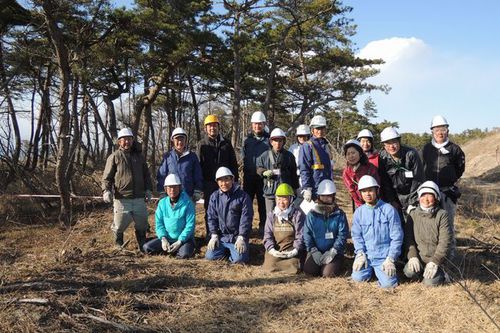December 12, 2014
Residents Work Together to Restore Coastal Pine Groves Damaged by Disasters
Keywords: Disaster Reconstruction

Copyright Watari Green Belt Project All Rights Reserved.
Tohoku Fukko Nikki (Tohoku Reconstruction Diary) is a weekly article in an eastern Japan newspaper called the Tokyo Shimbun. The weekly article delivers news and stories on reconstruction efforts in the areas devastated by the 2011 Great East Japan Earthquake. The series of articles is submitted by JKSK Empowering Women Empowering Society, a certified non-profit organization, about an initiative dubbed the "Yui-Yui Project," which supports victims of the earthquake.
This month, JFS introduces an article published on April 18, 2014, featuring residents' efforts to restore a pine grove that used to protect their town.
If you ever travelled along this area of Japan, did you notice the pine groves planted along the coast for the protection from high tides? In the Sendai Plain of Miyagi Prefecture, Japan, pine trees were planted for rice paddy development along the coast, in the era of Masamune Date (1567 - 1636), the first feudal lord of Sendai. These pine groves served as "bochorin" (tide-water control forests), minimizing damage from storm surges, tsunamis and winds, and allowing for rice farming.
The massive tsunami caused by the 2011 earthquake, however, swept away 1,400 hectares of the groves. The remaining portion of the groves had been left unmanaged for nearly three years, and as a result, invasive species such as the locust tree and desert false indigo bush have grown aggressively. Knowing the importance of coastal groves in disaster mitigation, local residents and experts had been expressing the need for clearing the underbrush to restore the groves' functions, but their voices had not been heard for a long time.
One of the reasons was that four coastal villages that used to be in charge of managing the grove in the town of Watari, south to Sendai, were severely damaged by the tsunami, leading to the dissolution of two villages and a severe drop in household numbers in two other villages. They dropped from 120 down to 20 households. Furthermore, in the midst of a huge amount of urgent reconstruction work, less urgent tasks such as the maintenance of the coastal grove were assigned a low priority. Financial constraints in the national and local governments also made it difficult. These challenges made residents think about solutions. After the disaster "reconstruction work" was done, how could they support each other in managing and maintaining the pine groves and other functions of their communities?
In response, every weekend for about eight weeks starting January 12, 2014, the Watari Green Belt Project (Watari GBP) cleared undergrowth of invasive species in the groves. This was a citizen-run project to restore and maintain the groves, with the participation of a total of 213 residents from Watari Town together with volunteers from all over Japan. In the past, the groves were maintained exclusively by the efforts of local communities, but now the project aims to involve the whole town plus volunteers from across the country in rejuvenating and managing the groves, and restoring the beautiful coastlines with the green belts. The Watari GBP has also teamed up with local elementary schools in providing integrated educational programs on seeding or plant nurseries to nurture the next generations of the activities.
The earthquake disaster may not be remembered forever, but people will continue to live there. What can we do to preserve beautiful landscapes and support communities? We will continue exploring solutions.
Kousuke Matsushima, head at the Watari Green Belt Project's office
Related
"JFS Newsletter"
- Aiming to Build New Communities in Earthquake-Stricken Areas: Ishinomaki Jichiren's Initiatives
- Investment to Help Disaster-affected Areas -- Initiative of Disaster Area Support Funds Initiative
- Disaster-Affected Ishinomaki -- Present Status (Part 2)
- Disaster-Affected Ishinomaki -- Present Status (Part 1)
- Tohoku and the World: 5 Years Since The Great East Japan Earthquake and Tsunami


